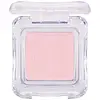What's inside
What's inside
 Key Ingredients
Key Ingredients

 Benefits
Benefits

No benefits
 Concerns
Concerns

 Ingredients Side-by-side
Ingredients Side-by-side

Dimethicone
EmollientMica
Cosmetic ColorantCI 77891
Cosmetic ColorantSynthetic Fluorphlogopite
Methyl Methacrylate Crosspolymer
Alumina
AbrasiveNeopentyl Glycol Diethylhexanoate
EmollientVinyl Dimethicone/Methicone Silsesquioxane Crosspolymer
Hexyl Laurate
EmollientCalcium Titanium Borosilicate
AbrasiveDimethicone/Vinyl Dimethicone Crosspolymer
Skin ConditioningDiphenyl Dimethicone/Vinyl Diphenyl Dimethicone/Silsesquioxane Crosspolymer
Magnesium Myristate
Nylon-12
Diglyceryl Sebacate/Isopalmitate
EmollientSorbitan Sesquiisostearate
EmulsifyingDipentaerythrityl Hexahydroxystearate
EmulsifyingMethylpropanediol
SolventSynthetic Wax
AbrasivePropanediol
SolventSilica
AbrasiveTriethoxycaprylylsilane
Hydrogenated Polyisobutene
EmollientPalmitic Acid
EmollientTocopherol
AntioxidantTin Oxide
AbrasiveCI 19140
Cosmetic ColorantCI 77491
Cosmetic ColorantCI 77510
Cosmetic ColorantDimethicone, Mica, CI 77891, Synthetic Fluorphlogopite, Methyl Methacrylate Crosspolymer, Alumina, Neopentyl Glycol Diethylhexanoate, Vinyl Dimethicone/Methicone Silsesquioxane Crosspolymer, Hexyl Laurate, Calcium Titanium Borosilicate, Dimethicone/Vinyl Dimethicone Crosspolymer, Diphenyl Dimethicone/Vinyl Diphenyl Dimethicone/Silsesquioxane Crosspolymer, Magnesium Myristate, Nylon-12, Diglyceryl Sebacate/Isopalmitate, Sorbitan Sesquiisostearate, Dipentaerythrityl Hexahydroxystearate, Methylpropanediol, Synthetic Wax, Propanediol, Silica, Triethoxycaprylylsilane, Hydrogenated Polyisobutene, Palmitic Acid, Tocopherol, Tin Oxide, CI 19140, CI 77491, CI 77510
Synthetic Fluorphlogopite
Silica
AbrasiveIsononyl Isononanoate
EmollientDimethicone
EmollientPolyisobutene
Phenyl Trimethicone
Skin ConditioningMica
Cosmetic ColorantPolymethylsilsesquioxane
Dimethicone Crosspolymer
Emulsion StabilisingHydroxystearic Acid
CleansingMicrocrystalline Wax
Emulsion StabilisingTin Oxide
AbrasivePhenoxyethanol
PreservativeCaprylyl Glycol
EmollientStearic Acid
CleansingCI 77891
Cosmetic ColorantCI 77491
Cosmetic ColorantIngredients Explained
These ingredients are found in both products.
Ingredients higher up in an ingredient list are typically present in a larger amount.
Ci 77491 is also hydrated iron III oxide. It's sole purpose is to give a red/pink hue to products.
Iron III oxides are classified as inorganic chemicals for coloring.
Synthetically created Ci 77491 is considered safer than those naturally found. This is because the synthetically created version may contain less impurities. Iron oxides are generally non-toxic and non-allergenic.
Learn more about CI 77491Ci 77891 is a white pigment from Titanium dioxide. It is naturally found in minerals such as rutile and ilmenite.
It's main function is to add a white color to cosmetics. It can also be mixed with other colors to create different shades.
Ci 77891 is commonly found in sunscreens due to its ability to block UV rays.
Learn more about CI 77891Dimethicone is a type of synthetic silicone created from natural materials such as quartz.
What it does:
Dimethicone comes in different viscosities:
Depending on the viscosity, dimethicone has different properties.
Ingredients lists don't always show which type is used, so we recommend reaching out to the brand if you have questions about the viscosity.
This ingredient is unlikely to cause irritation because it does not get absorbed into skin. However, people with silicone allergies should be careful about using this ingredient.
Note: Dimethicone may contribute to pilling. This is because it is not oil or water soluble, so pilling may occur when layered with products. When mixed with heavy oils in a formula, the outcome is also quite greasy.
Learn more about DimethiconeMica is a naturally occurring mineral used to add shimmer and color in cosmetics. It can also help improve the texture of a product or give it an opaque, white/silver color.
Serecite is the name for very fine but ragged grains of mica.
This ingredient is often coated with metal oxides like titanium dioxide. Trace amounts of heavy metals may be found in mica, but these metals are not harmful in our personal products.
Mica has been used since prehistoric times throughout the world. Ancient Egyptian, Indian, Greek, Roman, Aztec, and Chinese civilizations have used mica.
Learn more about MicaSilica, also known as silicon dioxide, is a naturally occurring mineral. It is used as a fine, spherical, and porous powder in cosmetics.
Though it has exfoliant properties, the function of silica varies depending on the product.
The unique structure of silica enhances the spreadability and adds smoothness, making it a great texture enhancer.
It is also used as an active carrier, emulsifier, and mattifier due to its ability to absorb excess oil.
In some products, tiny microneedles called spicules are made from silica or hydrolyzed sponge. When you rub them in, they lightly polish away dead skin layers and enhance the penetration of active ingredients.
Learn more about SilicaSynthetic Fluorphlogopite is the synthethic version of mica. It consists of fluorine, aluminum and silicate.
Synthetic Fluorphlogopite is used to add volume to products.
It is considered non-irritating on the skin.
Learn more about Synthetic FluorphlogopiteTin Oxide is an inorganic oxide used to add opacity and volume to a product. In nature, it is already found in mineral form. The main ore of tin is an opaque and shiny mineral called casseterite.
Tin Oxide helps remove translucency in a product, or make it more opaque. Besides adding opacity, tin oxide is used for bulking to add volume.